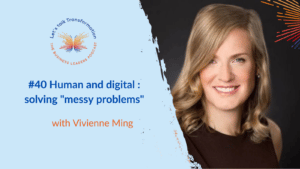“it’s not just about presence, it’s about culture and intentionally looking at the full spectrum of the employee journey “
Sam and I delve into the world of dynamic work and the different strategies available to organisations to create an equitable, inclusive and adaptable work policy as we come out of the pandemic and into a different world of work. What models do we nee d? How do we cater for everyone ?
Dynamic work strategies must be anchored in trust and used to further empower employees and leaders to make the best decisions and create new rituals for optimised performance. Listening to and acting upon employee feedback is key, as the workplace, organisational culture and digital technology evolve.
Sam shares her thoughts and experience from pioneering this topic both in OKTA and across other global businesses.
The main insights you’ll get from this episode are :
– Dynamic work is a broad remit seeking to maintain choice and flexibility for employees while maximising opportunities for engagement. Hybrid/remote working offers a big opportunity for companies to consider what goes into building a workforce.
– It encompasses the full spectrum of the employee lifecycle and journey and focuses also on community, equity, benefits, engagement, D&I, and belonging. The culture must foster a holistic environment where ‘place’ is purposeful and intentional in a post-pandemic world.
– Employees have reacted well thus far to the opportunity to better manage their work-life balance; the framework for this is anchored in trust – for employees to get work done and the company to provide extra support when necessary.
– Companies need to track premises utilisation and on-site presence: people may choose to come together in an office or meet locally where there is no office. This new ecosystem also brings a competitive advantage over companies who enforce on-site work.
– Adaptive culture is enabled by forward-leaning digital technology, e.g. an employee app to give cross-team visibility, a variety of zoom products, digital whiteboards, cloud-based on-demand printing, space sensors for (re)design purposes, virtual neighbourhoods, etc.
– Personal choice sees leaders offering transparency around their own decisions to go into the office or not; Okta have a new L&D unit to address leading differently for distributed teams looking at inclusion when working remotely, and new/more resources for managers.
– People are empowered by a dynamic work environment that still offers career development opportunities, and feel engaged and incentivised whether they are working remotely or on-site, for very different personal reasons.
– A belonging strategy is important with distributed teams and relies mostly on technical operations, such as home working/3rd party environment mirroring the office environment with the same equipment and amenities.
– Change management tools: individual meetings with executives and direct reports to discuss the tactics of dynamic work, discussions with HR, individual roadshows at business unit level, management being open to questions, a social intranet platform for dynamic work.
– To drive the philosophy and practices of dynamic working requires a targeted push-and-pull approach: employee engagement survey data reveals where the gaps are, and management must interact constantly with employees to obtain their feedback.
– Leaders must also constantly listen and pay attention to what is happening externally for employees and understand that new hires need/want different things and there is no one-size-fits-all solution.
– Companies are constantly changing their dynamic working environments due to push back from employees, so it is a moving baseline for many, but people-centric aspects will become more prevalent in functions/metrics/data.
– The future workplace will be based around experience and experience centres; melding internal teams with prospects and clients to achieve a strategic advantage; individual and different working styles will evolve as to how, where and when work gets done.
– Talent is tight, there is global economic pressure and evolving technology. The aim is to achieve what is best from a business perspective and attract and retain top talent by providing positive lifecycle and professional journeys within an organisation.
– Any hybrid model must match the company’s requirements based on employee feedback; culture and focus; maturity standpoint; client needs; streamlined technology stock; building the right services and programmes; a roadmap; and a high level of buy in.









